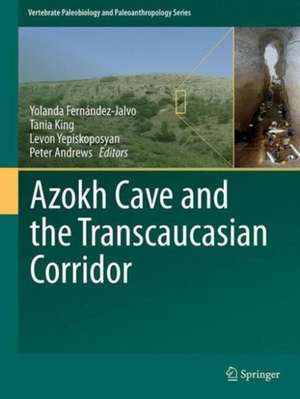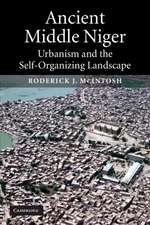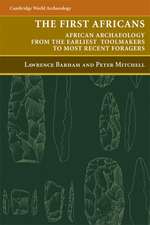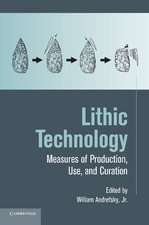Azokh Cave and the Transcaucasian Corridor: Vertebrate Paleobiology and Paleoanthropology
Editat de Yolanda Fernández-Jalvo, Tania King, Levon Yepiskoposyan, Peter Andrewsen Limba Engleză Hardback – 18 aug 2016
| Toate formatele și edițiile | Preț | Express |
|---|---|---|
| Paperback (1) | 405.48 lei 43-57 zile | |
| Springer International Publishing – 22 apr 2018 | 405.48 lei 43-57 zile | |
| Hardback (1) | 440.88 lei 38-44 zile | |
| Springer International Publishing – 18 aug 2016 | 440.88 lei 38-44 zile |
Din seria Vertebrate Paleobiology and Paleoanthropology
- 15%
 Preț: 717.13 lei
Preț: 717.13 lei -
 Preț: 314.69 lei
Preț: 314.69 lei - 15%
 Preț: 724.12 lei
Preț: 724.12 lei - 18%
 Preț: 738.34 lei
Preț: 738.34 lei - 18%
 Preț: 741.37 lei
Preț: 741.37 lei - 15%
 Preț: 719.39 lei
Preț: 719.39 lei - 18%
 Preț: 635.91 lei
Preț: 635.91 lei -
 Preț: 411.04 lei
Preț: 411.04 lei - 20%
 Preț: 606.45 lei
Preț: 606.45 lei -
 Preț: 392.60 lei
Preț: 392.60 lei - 20%
 Preț: 617.47 lei
Preț: 617.47 lei - 15%
 Preț: 650.19 lei
Preț: 650.19 lei -
 Preț: 397.38 lei
Preț: 397.38 lei - 20%
 Preț: 619.35 lei
Preț: 619.35 lei -
 Preț: 391.27 lei
Preț: 391.27 lei -
 Preț: 431.73 lei
Preț: 431.73 lei -
 Preț: 433.47 lei
Preț: 433.47 lei - 24%
 Preț: 715.31 lei
Preț: 715.31 lei -
 Preț: 449.63 lei
Preț: 449.63 lei - 24%
 Preț: 763.00 lei
Preț: 763.00 lei - 15%
 Preț: 715.31 lei
Preț: 715.31 lei - 24%
 Preț: 636.37 lei
Preț: 636.37 lei - 20%
 Preț: 631.45 lei
Preț: 631.45 lei - 18%
 Preț: 792.19 lei
Preț: 792.19 lei -
 Preț: 380.72 lei
Preț: 380.72 lei - 20%
 Preț: 604.46 lei
Preț: 604.46 lei - 15%
 Preț: 708.75 lei
Preț: 708.75 lei -
 Preț: 404.29 lei
Preț: 404.29 lei - 24%
 Preț: 645.20 lei
Preț: 645.20 lei -
 Preț: 383.95 lei
Preț: 383.95 lei - 18%
 Preț: 898.13 lei
Preț: 898.13 lei -
 Preț: 403.75 lei
Preț: 403.75 lei
Preț: 440.88 lei
Nou
Puncte Express: 661
Preț estimativ în valută:
84.39€ • 91.70$ • 70.93£
84.39€ • 91.70$ • 70.93£
Carte tipărită la comandă
Livrare economică 16-22 aprilie
Preluare comenzi: 021 569.72.76
Specificații
ISBN-13: 9783319249223
ISBN-10: 3319249223
Pagini: 772
Ilustrații: XVII, 349 p. 174 illus., 67 illus. in color.
Dimensiuni: 210 x 279 x 26 mm
Greutate: 1.34 kg
Ediția:1st ed. 2016
Editura: Springer International Publishing
Colecția Springer
Seria Vertebrate Paleobiology and Paleoanthropology
Locul publicării:Cham, Switzerland
ISBN-10: 3319249223
Pagini: 772
Ilustrații: XVII, 349 p. 174 illus., 67 illus. in color.
Dimensiuni: 210 x 279 x 26 mm
Greutate: 1.34 kg
Ediția:1st ed. 2016
Editura: Springer International Publishing
Colecția Springer
Seria Vertebrate Paleobiology and Paleoanthropology
Locul publicării:Cham, Switzerland
Cuprins
Introduction: Azokh Caves and the Transcaucasian corridor.- Stratigraphy and Sedimentology of Azokh Caves, South Caucasus.- Geology and Geomorphology of Azokh Caves.- Lithic Assemblages Recovered from Azokh 1.- Azokh Cave Hominin Remains.- The New Material of Large Mammals from Azokh and Comments on the Older Collections.- Rodents, Lagomorphs and Insectivores from Azokh Cave.- Bats from Azokh Caves.- Amphibians and Squamate Reptiles from Azokh 1.- Taphonomy and Site Formation of Azokh 1.- Bone Diagenesis at Azokh Caves.- Coprolites, Paleogenomics and Bone Content Analysis.- Palaeoenvironmental Context of Coprolites and Plant Microfossils from Unit II, Azokh 1.- Charcoal Remains from Azokh 1: Preliminary Results.- Paleoecology of Azokh 1.- Appendices.
Notă biografică
Dr. Yolanda Fernandez-Jalvo is a researcher at the Museo Nacional de Ciencias Naturales (CSIC), Spain in the Department of Paleobiology.
Dr. Tania King is co-Director with Dr. Fernández-Jalvo of the Azokh Project and afiliated to the Blandford Museum, UK.
Dr. Peter Andrews is a research scientist in the Department of Palaeontology, The Natural History Museum, London.
Dr. Levon Yepiskoposyan is Head of the Human Genetics Group at the Institute of Molecular Biology in the National Academy of Sciences, Armenia.
Textul de pe ultima copertă
his edited volume describes the geology, stratigraphy, anthropology, archaeology, dating, taphonomy, paleobotany, paleontology and paleoecology of Azokh caves (also known as Azykh or Azikh). The chapters review exhaustively the key recent research on this limestone karstic site, which is located near the village of the same name in the region of Nagorno Karabagh in the south-eastern end of the Lesser Caucasus. The site is significant due to its geographic location at an important migratory crossroad between Africa and Eurasia. These caves contain an almost complete sedimentary sequence of the transition between H.heidelbergensis and H. neanderthalensis continuing to later Pleistocene and Holocene stratified sediment. The site is also important due to the discovery of Neanderthal remains by the current research group in addition to the Middle Pleistocene hominin fossils during a previous phase of excavation work led by M. Huseinov. At the heart of thisbook is the matter of how this site relates to human evolution.
Caracteristici
Enables readers to gain a thorough understanding of the paleontology of Azokh Caves Contributions from internationally renowned experts from the field of geology, paleontology, archaeology, anthropology, and taphonomy Authoritative chapters on excavations and the palaeontological and archaeological material recovered from this site Includes supplementary material: sn.pub/extras












